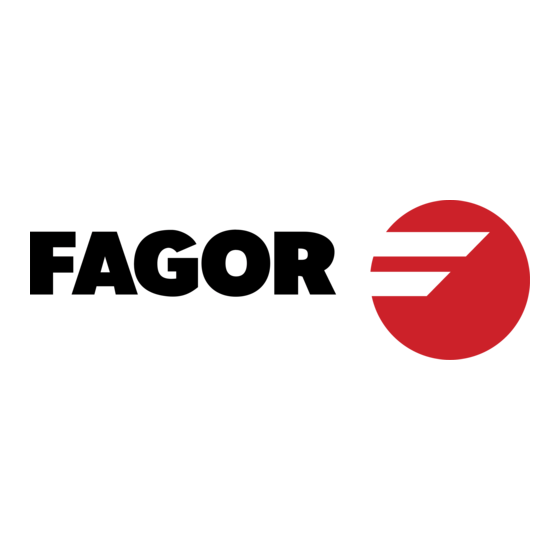
Table of Contents
Advertisement
Advertisement
Table of Contents

Summarization of Contents
Introduction
Safety Conditions
Essential safety measures for personnel and equipment to prevent damage and injury.
Material Returning Terms
Procedures for returning the CNC unit for repair or replacement, including packaging guidelines.
Fagor Documentation
Details on OEM and User manuals for the CNC system, including their purpose and content.
Peripherals
Front Panel Description
Overview of the CNC control panel, including display windows and function keys.
Peripheral Mode
How to access and use the peripheral mode for data transfer via RS232C.
"1-Output" Option: CNC --> Peripheral
Instructions for sending data from the CNC to a peripheral device.
"0-Input" Option: Peripheral --> CNC
Instructions for receiving data from a peripheral device into the CNC.
Aux Mode
System Input/Output Test
Procedure to analyze and test the CNC's logic inputs and outputs.
Machine Parameters
How to view and edit machine parameters to adapt the CNC to specific machine requirements.
Tool Table or Zero Offset Table
Accessing and managing the tool table or zero offset table for part programming.
Jog Mode
Jogging the Axes
Manual control of machine axes using jog keys or handwheel.
Automatic Positioning
Moving axes to a specific destination coordinate automatically.
Zero Setting or Coordinate Preset
Setting the current position as a new coordinate preset or zero point.
Machine Reference (Home) Search (G74)
Procedure for homing the machine axes to their reference positions.
Program Editing
Editing Mode
The primary mode for creating and modifying part programs block by block.
Displaying Block Contents
Viewing the functions programmed within specific blocks of a part program.
Program Editing
Step-by-step process for editing program blocks, defining functions, and saving changes.
Modifying Block Contents
Changing existing values or functions within a program block.
Inserting a New Program Block
Adding new blocks to an existing program, shifting subsequent blocks.
Teach-in Editing
Editing programs by executing blocks sequentially and storing them.
Play-back Editing
Editing programs by jogging axes to desired points and recording coordinates.
Program Execution
Program Execution
How to select execution modes (Single Block, Automatic) and start running programs.
Program Interruption
Methods to pause or stop program execution and resume it later.
Display Modes
Options for displaying axis position, M functions, counters, and other execution data.
Change of Operating Mode
Switching between Automatic and Single-Block modes during program execution.
Programming
Programming Format
Structure and syntax rules for writing part programs, including block and function definitions.
Preparatory G Functions
Detailed list and explanation of G-codes used for geometry and work conditions.
Basic Concepts
Understanding block numbers, conditional blocks, metric/inch, and absolute/incremental programming.
Reference Systems
Establishing machine reference zero, part zero, and machine reference points.
Machine Reference (Home) Search (G74)
Procedure for homing the machine axes to their reference positions.
Coordinate Preset and Zero Offsets
Applying zero offsets to define part origins relative to machine reference.
Complementary Functions
Functions like Axis Feedrate (F), Spindle Speed (S), Tool Number (T), and Auxiliary (M).
Path Control
Defining movement types like Rapid Positioning (G00), Linear (G01), and Circular Interpolation (G02/G03).
Additional Preparatory Functions
Functions like Dwell (G04) and Increment Part Counter (G45).
Special Functions
Functions like Feedback Inhibit (G47/G48) and Acceleration Ramp Modification (G93).
Others Functions
Includes Batch Programming (G81), Probing (G75), Rigid Tapping (G84/G80).
Parametric Programming
Using parameters to create flexible and dynamic part programs.














Need help?
Do you have a question about the 102 and is the answer not in the manual?
Questions and answers